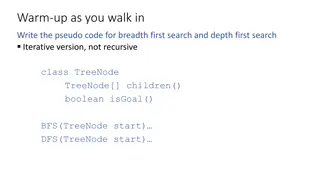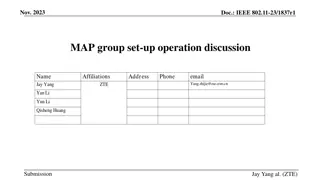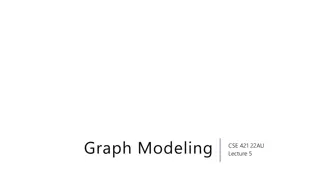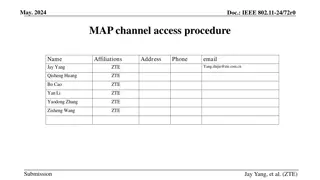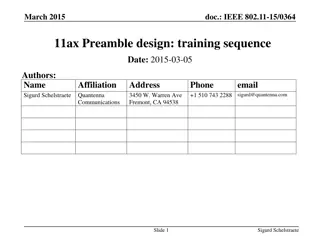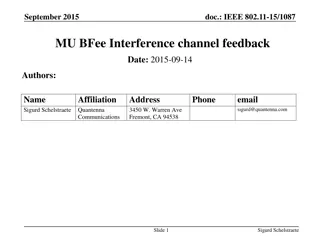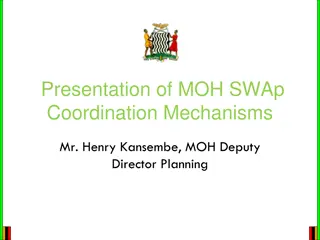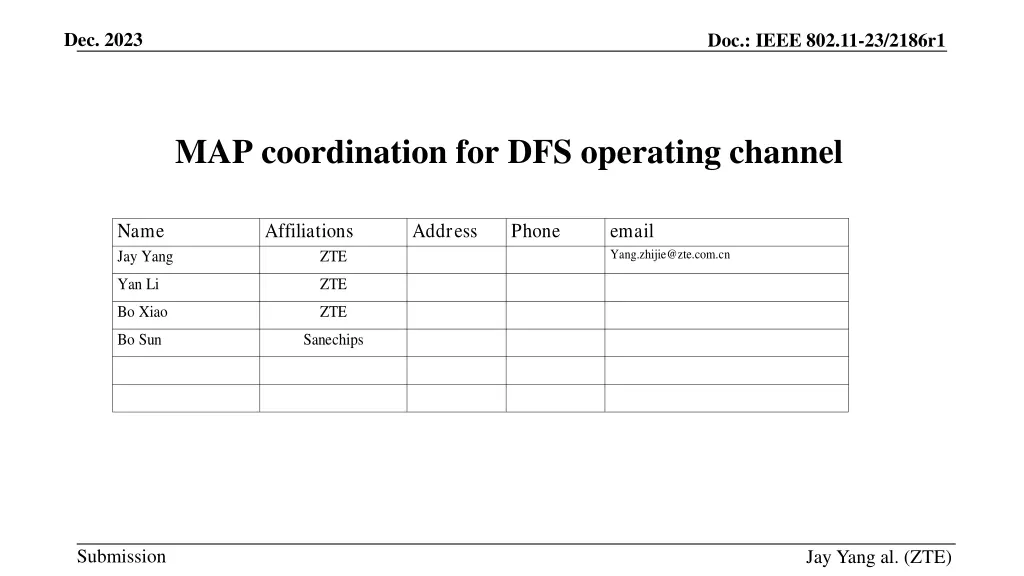
Efficient MAP Coordination for DFS Operating Channels in IEEE 802.11-23: Dec. 2023 Doc
Explore solutions for increasing throughput in 5GHz bands, focusing on Channel Availability Check (CAC) processes and issues related to AP operation. Learn about innovative approaches to mitigate performance challenges and optimize Wi-Fi service on DFS channels.
Download Presentation

Please find below an Image/Link to download the presentation.
The content on the website is provided AS IS for your information and personal use only. It may not be sold, licensed, or shared on other websites without obtaining consent from the author. If you encounter any issues during the download, it is possible that the publisher has removed the file from their server.
You are allowed to download the files provided on this website for personal or commercial use, subject to the condition that they are used lawfully. All files are the property of their respective owners.
The content on the website is provided AS IS for your information and personal use only. It may not be sold, licensed, or shared on other websites without obtaining consent from the author.
E N D
Presentation Transcript
Dec. 2023 Doc.: IEEE 802.11-23/2186r1 MAP coordination for DFS operating channel Name Jay Yang Affiliations Address Phone email Yang.zhijie@zte.com.cn ZTE Yan Li ZTE Bo Xiao ZTE Bo Sun Sanechips Submission Jay Yang al. (ZTE)
Dec. 2023 Doc.: IEEE 802.11-23/2186r1 Background UHR PAR illustration define at least one mode of operation capable of increasing throughput by 25% for both an isolated Basic Service Set (BSS) and overlapping BSSs 5GHz band operating rule(FCC,ETSI,MIIT,etc.) 5GHz band divides into DFS(owner s operating) channel and non-DFS channel. AP and STA can operate on the non-DFS channel immediately. AP shall perform Channel Availability Check(CAC) before operating on the target DFS channel, during which 5GHz signal is unavailable for connection. The Channel Availability Check process would take 1-10 minutes depending on the country. During CAC mode, only 2.4GHz AP is available for the Wi-Fi connection in 6GHz band unavailable country Conclusion CAC mode on 5GHz bands cause a seriously performance issue. Submission Slide 2 Jay Yang, et al. (ZTE)
Dec. 2023 Doc.: IEEE 802.11-23/2186r1 Popular solution on the high-end AP/STA products The popular solution on the high-end AP products Integrate a dedicated Radio+RF chain for radar signal detection. Having 4*4 RF chains on 5GHz band,operates on 4*4 mode in normal mode, switches to 3+1 mode in CAC mode. Note: [3+1] mode: 3 RF chains operates on the original channel, while 1 RF chain swithes to the target DFS channel and stays in CAC mode. Some high-end client or mobile AP/AP MLD may also integrate a scan radio The function is similar to the dedicated radio on some high-end APs. Submission Slide 3 Jay Yang, et al. (ZTE)
Dec. 2023 Doc.: IEEE 802.11-23/2186r1 The problem on cost-down AP products The status on cost-sensitive market 2*2 two-link AP products still dominate the residential market To reduce the cost,no scan radio integrated. Stop providing Wi-Fi service on 5GHz bands for 1 mins or 10 mins when the AP switches to a DFS channel or enlarge the operating Bandwidth across the DFS channel Submission Slide 4 Jay Yang, et al. (ZTE)
Dec. 2023 Doc.: IEEE 802.11-23/2186r1 Motivation Ideas: may I borrow your scan radio for Channel Available Check? Leverage 11bn MAP scheme, allow low-cost AP(AP1) to trigger high-end AP(AP2) to scan the expected DFS channel via AP2 s scan radio Allow AP1 to trigger an associated high-end STA to detect radar signal on DFS channel via the scan radio Benifit: avoid the Wi-Fi service interruption issue on AP1 in CAC mode without increasing the cost. Consideration: a uniformed radio measurement signaling should be defined to cover by infrastructure network and MAP coordination network. Submission Slide 5 Jay Yang, et al. (ZTE)
Dec. 2023 Doc.: IEEE 802.11-23/2186r1 The proposed procedure The proposed procedure is similar to Beacon request/report as bellow: AP1 AP2/STA 0.Scan radio information exchanged 1. DFS channel scan request 2. use the scan radio to detect radar signal on the requested DFS channel for 1 or 10 mins 3. DFS channel scan report 4. switch to DFS channel immediately if no radar signal detected Submission Slide 6 Jay Yang, et al. (ZTE)
Dec. 2023 Doc.: IEEE 802.11-23/2186r1 Summary Analyze the regulation rule of non-DFS and DFS channel on 5GHz band Analyze the main solution on high-end AP/STA to avoid performance issue during CAC mode Propose a scan radio sharing solution to address the performance issue during CAC procedure on low-cost AP product Submission Slide 7 Jay Yang, et al. (ZTE)
Dec. 2023 Doc.: IEEE 802.11-23/2186r1 THANK YOU Submission
Dec. 2023 Doc.: IEEE 802.11-23/2186r1 Reference [1]802.11bn PAR [2] ETSI EN 301 893 V2.1.1 [3] Revision of Part 15 of the Commission s Rules to Permit Unlicensed National Information Infrastructure (U-NII) Devices in the 5 GHz Band Submission Slide 9 Jay Yang, et al. (ZTE)
Dec. 2023 Doc.: IEEE 802.11-23/2186r1 SP1 Do you agree 11bn should define a radio measurement procedure on DFS channel? Note: the procedure may be used in both infrastructure network and MAP coordination network Submission Slide 10 Jay Yang, et al. (ZTE)








